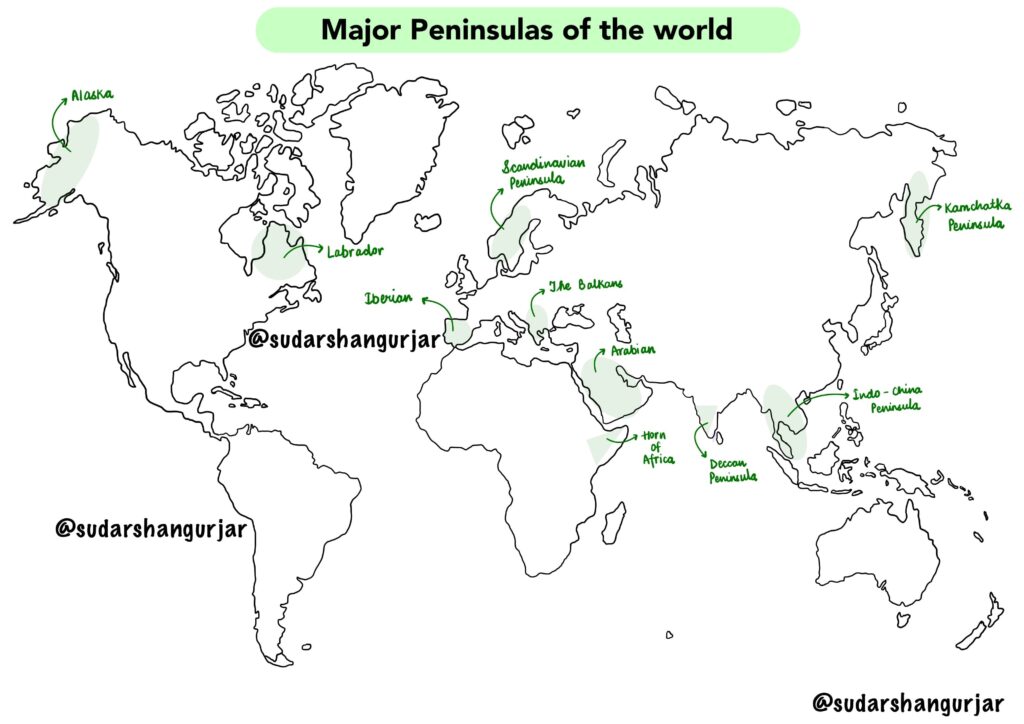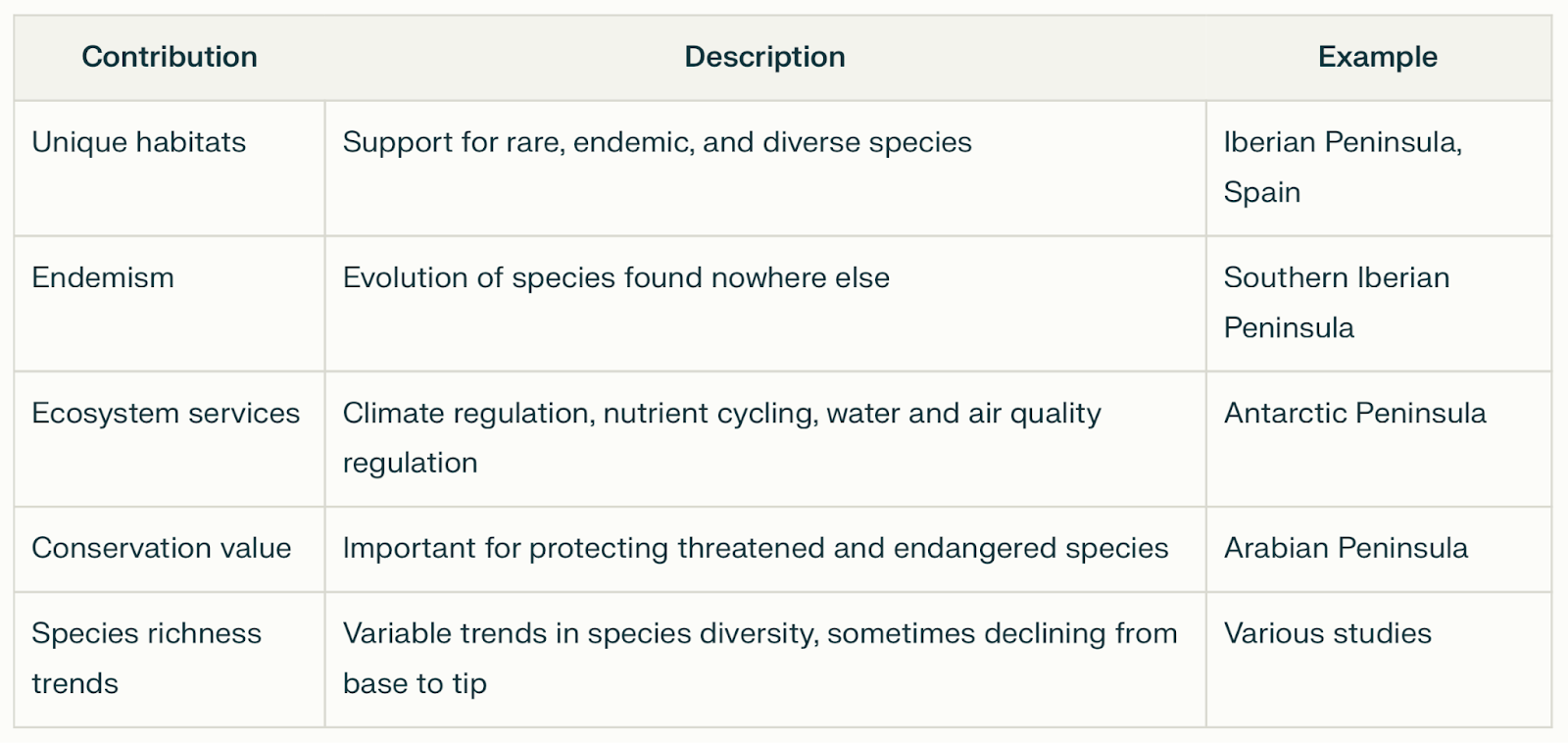A peninsula is a landform that extends out from the mainland and is surrounded by water on three sides. The word itself comes from the Latin “paene” meaning “almost” and “insula” meaning “island”-so, in essence, a peninsula is “almost an island.” While we often refer to these landforms as peninsulas, you might also hear them called headlands, capes, promontories, points, forks, or spits, depending on their shape and local terminology.
Interestingly, the concept of a peninsula isn’t limited to large landmasses. Even a river making a sharp, tight bend can create a small “peninsula” within its looping course. Peninsulas come in all sizes, from vast stretches like the Arabian Peninsula-one of the largest in the world-to much smaller projections of land.
Contribution of Peninsulas to Biodiversity and Ecosystems
- Unique Habitats and High Species Diversity
Peninsulas often support a remarkable variety of plant and animal life, including many species that are found nowhere else. Their distinct geographic position-surrounded by water on most sides but connected to the mainland-creates unique habitats that foster high biodiversity. These environments can harbor rare or endangered species, making peninsulas important areas for conservation efforts.
- Endemism and Conservation Value
The isolation provided by surrounding waters can lead to the evolution of endemic species-organisms that exist only in that specific region. For example, the southern Iberian Peninsula is noted for its high levels of biodiversity and endemism, particularly in coastal waters and freshwater habitats. This makes peninsulas critical for preserving genetic diversity and supporting unique ecological communities
- Ecosystem Services
Peninsulas contribute essential ecosystem services at both regional and global scales. For instance, the Antarctic Peninsula region plays a significant role in climate regulation, water and air quality, waste treatment, and nutrient cycling. These services benefit not only local environments but also have far-reaching impacts on global ecological processes.

- Species Richness Patterns: The Peninsula Effect
A well-studied phenomenon known as the “peninsula effect” suggests that species richness often declines from the base of a peninsula (where it connects to the mainland) toward its tip. However, this pattern is not universal and can vary depending on the type of species and local habitat conditions. Some taxa may show increased richness in the center or tip of a peninsula, while others decline, reflecting the complexity of ecological dynamics in these regions.
- Freshwater and Coastal Biodiversity
Peninsulas often contain diverse freshwater systems, such as rivers, wetlands, and marshes, which are vital for both human survival and the persistence of native flora and fauna. These freshwater habitats are typically unique and highly valued, as seen in the Arabian Peninsula, where they are crucial for species conservation and ecosystem health.

Unique Geological Features of Peninsulas
1. Diverse Formation Processes
- Peninsulas can form through a variety of geological processes, including tectonic activity (such as the uplift or rifting of land), volcanic eruptions, glacial deposition, and sedimentary accumulation.
- For example, the Alaska Peninsula was formed from volcanic rock over millions of years, while the Arabian Peninsula is a classic rift peninsula, created by tectonic plate separation.
2. Varied Rock Types and Structures
- Depending on their origin, peninsulas may be composed of volcanic, sedimentary, or metamorphic rocks. Cape Cod, for instance, is made of glacial drift and sedimentary rock, while Florida’s bedrock consists of thick layers of marine limestone formed from ancient sea life.
3. Distinct Landforms
- Peninsulas often feature unique landforms such as:
- Plateaus and hill ranges (e.g., Peninsular India)
- Block mountains, rift valleys, and spurs
- Bare rocky outcrops, hummocky hills, and quartzite dykes
- Narrow necks of land (isthmuses) connecting them to the mainland
- Sand spits and capes, which are smaller peninsular forms shaped by coastal processes
4. Glacial and Coastal Influences
- Some peninsulas, like Michigan’s, were carved by glacial activity, leaving behind deep lakes and rugged terrain.
- Coastal peninsulas often display dramatic cliffs, beaches, and estuaries due to constant interaction with water and erosion.
5. Ecological and Topographical Diversity
- The interaction of land and water leads to varied microclimates, soil types, and habitats, supporting rich biodiversity and unique ecosystems.
Peninsulas, therefore, are geologically diverse, shaped by a range of natural forces, and often display striking landforms and rock structures that set them apart from other landforms.
Major Peninsulas of the World
Below is a list of some of the most important peninsulas, organized by size and global significance, along with brief descriptions.
- Arabian Peninsula
- Location: Western Asia, northeast of Africa
- Area: ~1,250,000 square miles (3.2 million sq. km)
- Countries: Saudi Arabia, Yemen, Oman, UAE, Qatar, Bahrain, Kuwait, parts of Jordan and Iraq
- Boundaries: Red Sea (west), Persian Gulf (northeast), Arabian Sea (southeast), connected to the Levant (north)
- Features: The largest peninsula in the world, dominated by vast deserts (such as the Rub’ al Khali), mountain ranges (Hejaz), and arid plateaus. It is a global center for oil and natural gas production, making it geopolitically vital.
- Deccan (Indian) Peninsula
- Location: Southern India
- Area: ~800,000 square miles (2.07 million sq. km)
- Boundaries: Arabian Sea (west), Bay of Bengal (east), Indian Ocean (south)
- Features: Characterized by the Deccan Plateau, flanked by the Western and Eastern Ghats. It is agriculturally rich and historically significant, with major rivers like the Godavari and Krishna.
- Indochina Peninsula
- Location: Southeast Asia
- Area: ~748,000 square miles (1.94 million sq. km)
- Countries: Myanmar, Thailand, Laos, Cambodia, Vietnam, Malaysia (part)
- Boundaries: Andaman Sea, South China Sea, Gulf of Thailand
- Features: Known for its tropical climate, fertile river deltas (Mekong, Irrawaddy), and rich cultural diversity.
- Horn of Africa
- Location: Eastern Africa
- Area: ~726,000 square miles (1.88 million sq. km)
- Countries: Somalia, Ethiopia, Eritrea, Djibouti
- Boundaries: Gulf of Aden, Arabian Sea, Indian Ocean
- Features: Noted for its arid landscapes, unique wildlife, and strategic location along major maritime routes.
- Alaskan Peninsula
- Location: Southwestern Alaska, USA
- Area: ~579,000 square miles (1.5 million sq. km)
- Boundaries: Pacific Ocean (south), Bering Sea (north)
- Features: Rugged terrain, volcanic mountains, and abundant wildlife. It acts as a gateway to the Aleutian Islands.
- Labrador Peninsula
- Location: Eastern Canada
- Area: ~540,000 square miles (1.4 million sq. km)
- Boundaries: Hudson Bay (west), Labrador Sea (east), Gulf of St. Lawrence (south)
- Features: Dominated by boreal forests and tundra, with numerous lakes and rivers.
- Scandinavian Peninsula
- Location: Northern Europe
- Area: ~289,000 square miles (749,000 sq. km)
- Countries: Norway, Sweden, part of Finland
- Boundaries: Norwegian Sea, North Sea, Baltic Sea
- Features: Famous for its fjords, mountains, and extensive forests. It is known for high living standards and advanced economies.
- Balkan Peninsula
- Location: Southeastern Europe
- Area: ~257,000 square miles (666,000 sq. km)
- Countries: Includes Greece, Albania, Bulgaria, North Macedonia, Serbia, Bosnia and Herzegovina, Croatia, Montenegro, Slovenia, parts of Romania and Turkey
- Boundaries: Adriatic Sea, Mediterranean Sea, Aegean Sea, Black Sea
- Features: Mountainous terrain, rich history, and cultural diversity.
- Iberian Peninsula
- Location: Southwestern Europe
- Area: ~224,000 square miles (581,000 sq. km)
- Countries: Spain, Portugal, Andorra, Gibraltar (UK), small part of France
- Boundaries: Atlantic Ocean (west), Mediterranean Sea (east)
- Features: Diverse landscapes, including mountains (Pyrenees), plateaus, and river valleys. It has played a key role in European history and exploration.
- Korean Peninsula
- Location: East Asia
- Area: ~85,000 square miles (220,000 sq. km)
- Countries: North Korea, South Korea
- Boundaries: Yellow Sea (west), Sea of Japan/East Sea (east), Korea Strait (south)
- Features: Mountainous in the north, with fertile plains in the south. It is a region of political tension and economic dynamism.
- Floridian Peninsula
- Location: Southeastern United States
- Area: ~65,000 square miles (170,000 sq. km)
- Boundaries: Gulf of Mexico (west), Atlantic Ocean (east), Florida Strait (south)
- Features: Known for its wetlands (Everglades), beaches, and subtropical climate.
- Baja California Peninsula
- Location: Northwestern Mexico
- Area: ~55,000 square miles (143,000 sq. km)
- Boundaries: Pacific Ocean (west), Gulf of California (east)
- Features: Arid desert, rugged mountains, and rich marine biodiversity. Famous for whale watching and unique landscapes.
- Italian Peninsula
- Location: Southern Europe
- Area: ~50,000 square miles (131,000 sq. km)
- Countries: Italy, San Marino, Vatican City
- Boundaries: Adriatic Sea, Ionian Sea, Tyrrhenian Sea, Mediterranean Sea
- Features: The “boot-shaped” peninsula is renowned for its historical cities, rolling hills, and Mediterranean climate.
- Kola Peninsula
- Location: Northwestern Russia
- Area: ~39,000 square miles (100,000 sq. km)
- Boundaries: Barents Sea (north), White Sea (east)
- Features: Arctic climate, tundra landscapes, and significant mineral resources. It is important for Russia’s naval and mining industries.
- Sinai Peninsula
- Location: Egypt (the only part of Egypt in Asia)
- Area: ~23,000 square miles (60,000 sq. km)
- Boundaries: Mediterranean Sea (north), Red Sea (south), Suez Canal (west), Gulf of Aqaba (east)
- Features: Desert terrain, religious significance (Mount Sinai), and a strategic location connecting Africa and Asia.
- Crimean Peninsula
- Location: Northern coast of the Black Sea, Eastern Europe
- Area: ~10,400 square miles (27,000 sq. km)
- Boundaries: Black Sea (south and west), Sea of Azov (northeast)
- Features: Mild climate, scenic coastlines, and a history of geopolitical conflict.
- Yucatán Peninsula
- Location: Southeastern Mexico, northern Central America
- Boundaries: Gulf of Mexico (north and west), Caribbean Sea (east)
- Features: Known for its limestone caves, cenotes, and Mayan archaeological sites.
- Malay Peninsula
- Location: Southeast Asia
- Countries: Southern Thailand, Peninsular Malaysia, part of Myanmar
- Boundaries: Andaman Sea (west), South China Sea (east), Strait of Malacca (south)
- Features: Tropical rainforests, diverse wildlife, and bustling cities.
- Kamchatka Peninsula
- Location: Russian Far East, northeastern Asia
- Boundaries: Sea of Okhotsk (west), Pacific Ocean and Bering Sea (east)
- Features: It is a rugged, mountainous region dominated by two major mountain ranges: the Central (Sredinny) Range and the Eastern (Vostochny) Range. The peninsula hosts around 150 volcanoes, with 29 still active, including Klyuchevskaya Sopka-the highest active volcano in the Northern Hemisphere at 4,750 meters. The terrain includes volcanic peaks, river valleys, and extensive wilderness areas. The Kamchatka River runs through the central trough between the mountain ranges.
Other Notable Peninsulas
- Chukchi Peninsula (Russia): The easternmost part of Russia, facing Alaska across the Bering Strait. It has a harsh Arctic climate and is sparsely populated.
- Tasman Peninsula (Australia): Located in southeastern Tasmania, known for dramatic cliffs and historical sites.
- Nicoya Peninsula (Costa Rica): Famous for its biodiversity and as a “Blue Zone” where people live exceptionally long lives

0 Comments